新生代英语高级教程2+unit+6_教学设计
- 格式:pdf
- 大小:255.61 KB
- 文档页数:10
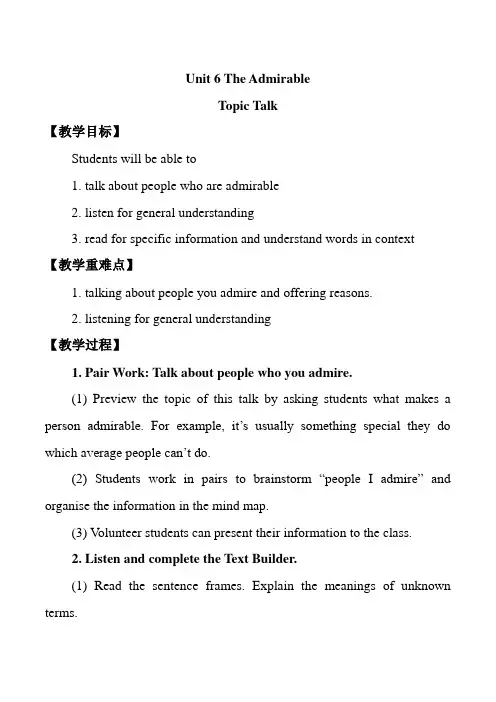
Unit 6 The AdmirableTopic Talk【教学目标】Students will be able to1. talk about people who are admirable2. listen for general understanding3. read for specific information and understand words in context【教学重难点】1. talking about people you admire and offering reasons.2. listening for general understanding【教学过程】1. Pair Work: Talk about people who you admire.(1) Preview the topic of this talk by asking students what makes a person admirable. For example, it’s usually something special they do which a verage people can’t do.(2) Students work in pairs to brainstorm “people I admire” and organise the information in the mind map.(3) V olunteer students can present their information to the class.2. Listen and complete the Text Builder.(1) Read the sentence frames. Explain the meanings of unknown terms.(2) Discuss what the dialogue could be about.(3) Play the dialogue.(4) Ask students to recall the information they heard in the talk to complete the sentences. If needed, play the dialogue a second time and pause after key statements in the interview.(5) Review the answers with students.3. Use the Text Builder to talk about the person you admire.(1) Ask students to call out words/phrases they learnt in this section, such as brave, help people in danger, weakness and work hard and creatively.(2) Then have students talk about the person they admire in different pairs or small groups.4. Listen, complete and discuss.(1) Tell students that they should write three qualities while listening, one in each box.(2) Ask students to tell a partner what they expect to hear, e.g., people who are admirable and what makes them admirable.(3) Play the dialogue.(4) Play the dialogue a second time if needed and pause after key statements in the dialogue.(5) Review the answers as a class.(6) Have students discuss in pairs or small groups whether they agree or disagree with the qualities mentioned in the dialogue. Encourage them to give reasons for their answers.(7) V olunteer students can share their opinions with the class.5. Write a short paragraph about the person you admire.(1) Ask students to choose a person they admire.(2) Refer students back to the Text Builder to write a short paragraph. Help struggling students with ideas and sentence structure.(3) V olunteer students can read their paragraph in small groups or to the class. Find out whether the students have similar ideas on the people that they admire.。
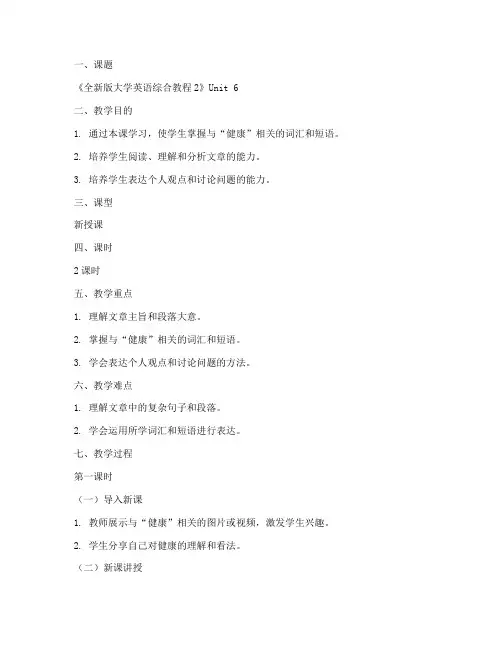
一、课题《全新版大学英语综合教程2》Unit 6二、教学目的1. 通过本课学习,使学生掌握与“健康”相关的词汇和短语。
2. 培养学生阅读、理解和分析文章的能力。
3. 培养学生表达个人观点和讨论问题的能力。
三、课型新授课四、课时2课时五、教学重点1. 理解文章主旨和段落大意。
2. 掌握与“健康”相关的词汇和短语。
3. 学会表达个人观点和讨论问题的方法。
六、教学难点1. 理解文章中的复杂句子和段落。
2. 学会运用所学词汇和短语进行表达。
七、教学过程第一课时(一)导入新课1. 教师展示与“健康”相关的图片或视频,激发学生兴趣。
2. 学生分享自己对健康的理解和看法。
(二)新课讲授1. 学生自读课文,了解文章大意。
2. 教师讲解课文中的重点词汇和短语,如:healthy, fitness, diet, exercise 等。
3. 分析文章结构,讲解段落大意。
(三)巩固练习1. 学生完成课文后的练习题,巩固所学知识。
2. 教师讲解练习题的答案和解析。
(四)课堂讨论1. 学生分组讨论课文中的观点和问题。
2. 各组代表发言,分享讨论结果。
第二课时(一)复习导入1. 回顾上一节课的重点内容。
2. 学生分享自己在健康方面的经验和建议。
(二)新课讲授1. 教师讲解与“健康”相关的语法知识,如:一般现在时、一般过去时等。
2. 学生练习运用所学语法知识进行表达。
(三)巩固练习1. 学生完成课文后的练习题,巩固所学知识。
2. 教师讲解练习题的答案和解析。
(四)写作训练1. 学生根据课文内容,写一篇关于健康的短文。
2. 教师批改学生的作文,并给予反馈。
八、板书设计Unit 6:Healthy Lifestyle1. Healthy:健康的2. Fitness:健身3. Diet:饮食4. Exercise:锻炼5. Healthy eating:健康饮食6. Regular exercise:定期锻炼7. Maintain a healthy lifestyle:保持健康的生活方式九、教具准备1. 多媒体课件2. 白板或黑板3. 练习题十、课后作业1. 复习本课所学词汇和短语。

新生代英语高级教程2unit6
【实用版】
目录
1.课文概述
2.课文主题:科技与生活
3.课文结构
4.重点词汇与短语
5.练习与讨论
正文
一、课文概述
《新生代英语高级教程 2unit6》是一篇关于科技与生活的课文。
课
文通过描述科技在人们日常生活中的应用,强调科技对我们生活的重要性,并引导读者思考科技带来的利与弊。
二、课文主题:科技与生活
课文的主题是科技与生活。
课文列举了许多科技产品,如智能手机、电子邮件、社交媒体和在线购物等,这些产品已经深入到我们日常生活中,极大地改变了我们的生活方式。
三、课文结构
课文分为三部分。
第一部分介绍了科技在我们生活中的各种应用,如通讯、娱乐、学习和工作等。
第二部分讨论了科技带来的好处,如提高生活质量、提高工作效率和方便人际交流等。
第三部分探讨了科技带来的问题,如信息泄露、网络成瘾和隐私侵犯等。
四、重点词汇与短语
1.Smartphone: 智能手机
2.E-mail: 电子邮件
3.Social media: 社交媒体
4.Online shopping: 在线购物
rmation leakage: 信息泄露
6.Internet addiction: 网络成瘾
7.Privacy invasion: 隐私侵犯
五、练习与讨论
1.根据课文内容,列举五种科技产品,并说明它们如何改变我们的生活。
2.分组讨论:科技给我们带来了哪些好处?哪些问题?
3.思考:如何在享受科技带来的便利的同时,避免科技带来的负面影响?。
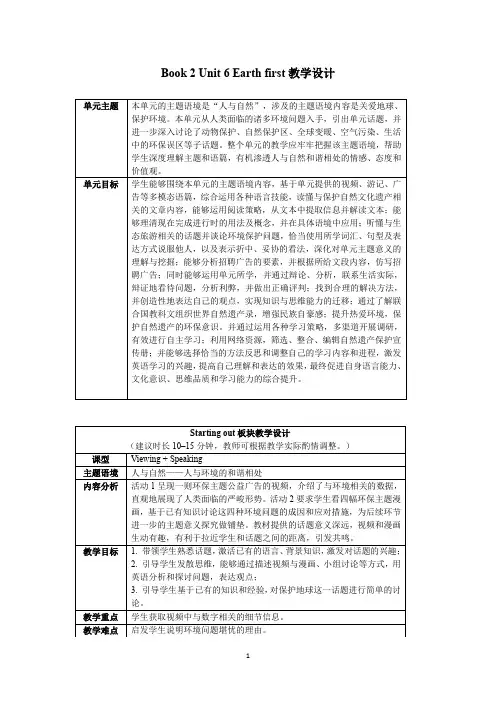
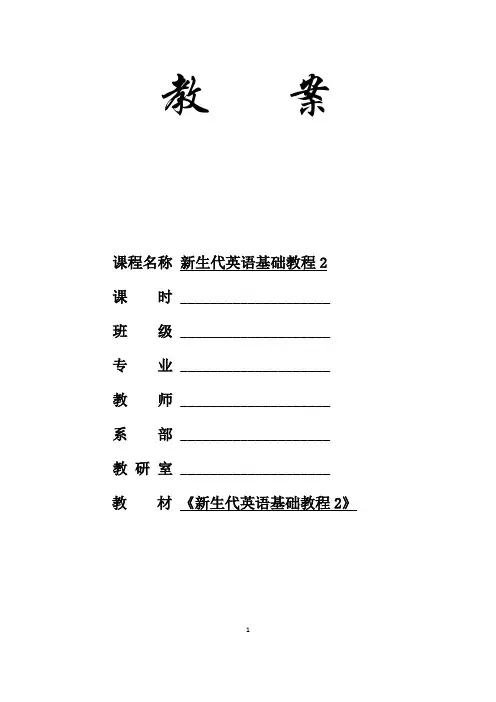
教案课程名称新生代英语基础教程2课时____________________班级____________________专业____________________教师____________________系部____________________教研室____________________教材《新生代英语基础教程2》12345678补充教学资源VOCABULARY BUILDERREADING➢背景知识Comfortlessness happens frequently in daily life. In most cases, home remedies are all that’s needed. E.g. , the best home remedy for colds is to have two cloves of raw garlic at the onset of symptoms. Ginger, a home remedy for helping an upset stomach. Some people still prefer the age-old home remedy of baking soda and a toothbrush to gently whiten teeth at home.➢语言解析1. Do you know these home remedies?你知道这些家庭疗法吗?9remedy n.补救法,解决方法,药物e.g. ①Honey is an excellent home remedy for sore throats.蜂蜜是治疗喉咙疼痛的极佳的家庭疗法。
②What is my remedy in law in this case?这件事情我能采取什么法律手段?2. Sometimes, you can find natural cures in your home which are just as good as what you can find in the pharmacy.有时候,你能在家里找到同药店里效果一样好的天然药品。
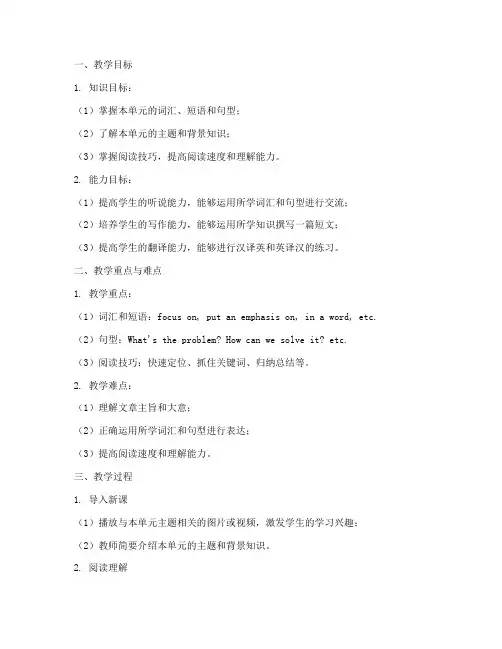
一、教学目标1. 知识目标:(1)掌握本单元的词汇、短语和句型;(2)了解本单元的主题和背景知识;(3)掌握阅读技巧,提高阅读速度和理解能力。
2. 能力目标:(1)提高学生的听说能力,能够运用所学词汇和句型进行交流;(2)培养学生的写作能力,能够运用所学知识撰写一篇短文;(3)提高学生的翻译能力,能够进行汉译英和英译汉的练习。
二、教学重点与难点1. 教学重点:(1)词汇和短语:focus on, put an emphasis on, in a word, etc.(2)句型:What's the problem? How can we solve it? etc.(3)阅读技巧:快速定位、抓住关键词、归纳总结等。
2. 教学难点:(1)理解文章主旨和大意;(2)正确运用所学词汇和句型进行表达;(3)提高阅读速度和理解能力。
三、教学过程1. 导入新课(1)播放与本单元主题相关的图片或视频,激发学生的学习兴趣;(2)教师简要介绍本单元的主题和背景知识。
2. 阅读理解(1)让学生快速浏览文章,了解文章大意;(2)教师引导学生分析文章结构,找出文章主题句;(3)针对文章中的难句和重点词汇进行讲解,帮助学生理解文章内容;(4)让学生完成阅读练习,巩固所学知识。
3. 词汇学习(1)教师带领学生复习本单元的词汇,并举例说明;(2)让学生运用所学词汇进行造句,提高词汇运用能力。
4. 听力训练(1)播放与本单元主题相关的听力材料,让学生进行听力训练;(2)教师讲解听力技巧,帮助学生提高听力水平;(3)让学生完成听力练习,巩固所学知识。
5. 口语表达(1)教师组织学生进行口语对话,让学生运用所学词汇和句型进行交流;(2)教师进行点评和指导,提高学生的口语表达能力。
6. 写作训练(1)教师给出写作话题,让学生运用所学知识进行写作;(2)教师进行点评和指导,提高学生的写作能力。
7. 总结与布置作业(1)教师对本节课的学习内容进行总结,强调重点和难点;(2)布置课后作业,包括阅读、听力、词汇、口语和写作练习。
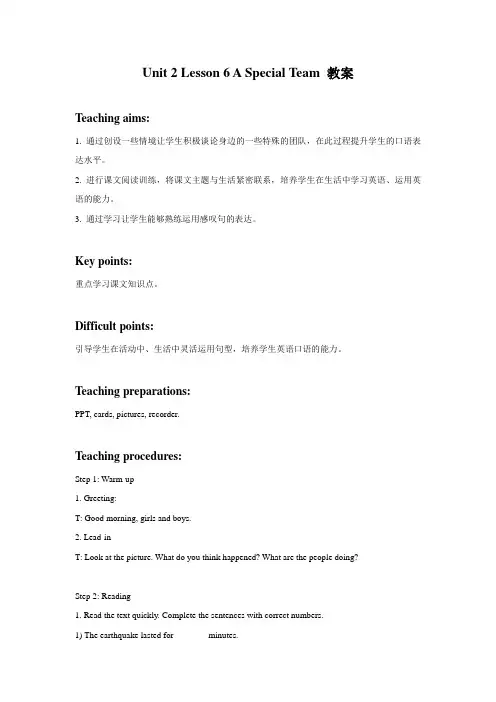
Unit 2 Lesson 6 A Special Team 教案Teaching aims:1. 通过创设一些情境让学生积极谈论身边的一些特殊的团队,在此过程提升学生的口语表达水平。
2. 进行课文阅读训练,将课文主题与生活紧密联系,培养学生在生活中学习英语、运用英语的能力。
3. 通过学习让学生能够熟练运用感叹句的表达。
Key points:重点学习课文知识点。
Difficult points:引导学生在活动中、生活中灵活运用句型,培养学生英语口语的能力。
Teaching preparations:PPT, cards, pictures, recorder.Teaching procedures:Step 1: Warm-up1. Greeting:T: Good morning, girls and boys.2. Lead-inT: Look at the picture. What do you think happened? What are the people doing?Step 2: Reading1. Read the text quickly. Complete the sentences with correct numbers.1) The earthquake lasted for _______ minutes.2) The Lins found ________ people at the resort.3) Mr Lin divided the 25 people into ______ groups.4) It took the team ________ hours to get out safety.2. Read the text again and answer the questions.1) Why didn’t the group go down the mountain right after the earthquake?2) What problems did the group have?3) Hoe did the team solve the problems?4) What did the group leaders do at night?Step 3: Speaking (pair work)T: What special teams can you think of? Tell your partner. Include these details.1) Who are in the team?2) What does the team do?3) Why do you think the team is special?4) What can you learn from this team?Example:Astronauts work as a special team. Each one of them has different skills, but they must help each other.Step 4: Homework1. Memory all the new words and expressions.2. What special teams can you think of?。
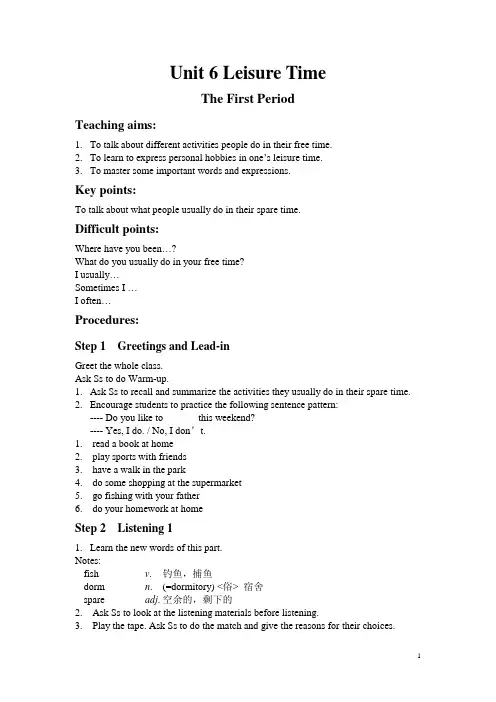
Unit 6 Leisure TimeThe First PeriodTeaching aims:1.To talk about different activities people do in their free time.2.To learn to express personal hobbies in one’s leisure time.3.To master some important words and expressions.Key points:To talk about what people usually do in their spare time.Difficult points:Where have you been…?What do you usually do in your free time?I usually…Sometimes I …I often…Procedures:Step 1 Greetings and Lead-inGreet the whole class.Ask Ss to do Warm-up.1.Ask Ss to recall and summarize the activities they usually do in their spare time.2.Encourage students to practice the following sentence pattern:---- Do you like to ______ this weekend?---- Yes, I do. / No, I don’t.1. read a book at home2. play sports with friends3. have a walk in the park4. do some shopping at the supermarket5. go fishing with your father6. do your homework at homeStep 2 Listening 11.Learn the new words of this part.Notes:fish v. 钓鱼,捕鱼dorm n. (=dormitory) <俗> 宿舍spare adj. 空余的,剩下的2. Ask Ss to look at the listening materials before listening.3. Play the tape. Ask Ss to do the match and give the reasons for their choices.4.Play the tape again, and then check the answers with the whole class.Script of listening:1.Susan likes to go to the cinema with her friends.2.Jack likes to play cards in his dorm.ura likes to watch TV in the library.4.Tom likes to play football on weekends.Step 3 Dialogue 11.Have students discuss the relationship between the two speakers and where thedialogue take place.2.Explain the important phrases and divide the students into 3 groups to discuss andcomplete the dialogue with the words given below.3.Play the tape and ask Ss to read after it, and then ask Ss to play the dialogue.4.Remember the following important phrases:Where have you been…?What do you usually do in your free time?I usually…Sometimes I …I often…Step 4 Role Play 11.Practise the important phrases and words.2.Ask Ss to practise the dialogue as Dialogue 1. Ask some Ss to play the dialogue infront of the class.3.Ask Ss to practise more about this pattern.Step 5 Homework1.Make a dialogue in pairs with the knowledge learnt today.2.Copy the new words three times.3.Recite the dialogue 1 on page85.The Second PeriodTeaching aims:1.To enable students to talk about their favorite books and magazines.2.To learn about different types of books.Key points:How to talk about reading.Difficult points:I like… because…What …do you like to read...?Books are good to everyone, aren’t they?Procedures:Step 1 Greetings and Lead-inGreet the whole class.Review the important phrases learned last period.Step 2 Listening 21.Learn the new words of this part.Notes:novel n.小说,长篇故事newspaper n.报纸magazine n.杂志,期刊adventure n.冒险,冒险的经历detective adj.侦探的autumn n.秋天2.Ask Ss to look at the pictures, make sure they can recognize the items in thepictures.3.Play the tape, and ask Ss to do the match, and pay attention to the words aboutanger.4.Play the tape again, and then check the answers with the whole class.Script of listening:1. She likes reading children’s books.2. He likes reading magazines.3. She likes reading Harry Potter.4. He likes reading Shakespeare’s plays.Step 3 Dialogue 21.Explain some important words and useful sentences. Encourage Ss to make somesentences.2.Practise how to fill the blanks correctly by guessing before filling the words.3.Play the tape and Ss read after it. Then ask some Ss to play the dialogue.4.Remember the following important phrases:I like… because…What …do you like to read...?Books are good to everyone, aren’t they?Step 4 Role Play 21.Practise the important phrases and words.2.Ask Ss to practise the dialogue as Dialogue 2.Step 5 Homework1.Make a dialogue in pairs with the knowledge learnt today.2.Copy the new words three times.3.Recite the dialogue on page 86.The Third Period Teaching aims:1.To learn about the types of musical instruments and rock bands.2.Introduce the history of rock music and the Beatles.3.To master some words and phrases.Key points:Talk about the types of musical instruments and rock bands. Difficult points:Have you ever heard about…?They’re my favorite music group.I’m going to buy…Procedures:Step 1 Greetings and Lead-inGreet the whole class.Review the important phrases learned last period.Step 2 Listening 31.Learn the new words of this part.Notes:violin n.小提琴drum n.鼓;鼓声guitar n. 吉他,六弦琴saxophone n. [音] 萨克斯管(铜管类乐器)flute n. 长笛classical adj. 古典的;正统的jazz n. 爵士乐2.Ask Ss to look at the words, and ask them to guess what they are going to listen.3.Play the tape, and ask Ss to match the answers.4.Play the tape again, and then check the answers with the whole class.Script of Listening 31. My teacher is playing the piano.2. Miss Li is playing the flute.3. Mr White is playing the violin.4. Our music teacher is playing the saxophone.5. Mrs Miller is playing the drum.6. My friend is playing the guitar.Step 3 Dialogue 31.Introduce the history of rock music and the Beatles briefly to students.2.Have the students work in groups and fill in the blanks with the words given.3.Play the tape and Ss read after it. Then ask some Ss to play the dialogue.4.Let Ss talk about their favorite music groups.5.Remember the following important phrases:Have you ever heard about…?They’re my favorite music group.I’m going to buy…Step 4 Role Play 31.Explain the important words and phrases, and then practise them.2.Ask Ss to practise the dialogue as Dialogue3.Step 5 Homework1.Make a dialogue in pairs with the knowledge learnt today.2.Copy the new words three times.3.Recite the dialogue on page 88.The Fourth Period Teaching aims:1.To talk about adventure stories, like Harry Potter and it’s writer.2.To learn how to collect useful information from the Internet..3.To master some words and phrases.Key points:Talking about adventure stories.Difficult points:Created by…Series ofTell aboutChange… into …Live a … lifeTogether withHome toProcedures:Step 1 Greetings and Lead-inGreet the whole class.Review the dialogue 3 learned last period.Step 2 Pre-reading Activities1.Learn the new words of this part.Notes:amazing adj. 令人惊异的best-selling adj. 最畅销的wizard n. 男巫sorcerer n. 男巫士,魔术师orphan n. 孤儿horrible adj. 可怕的,恐怖的uncle n. 伯父,叔父,姑父magician n. 魔术师magic adj. 魔术的,有魔力的metal n. 金属chamber n. 室,房间hide v.(hid, hidden) 隐藏,掩饰monster n. 怪物,妖怪bravely adv. 勇敢地fight v. (fought, fought) 搏斗,对抗evil n. 邪恶,罪恶2.Have students talk about their favorite adventure stories in groups and collect thenames on the blackboard.3.Raise the following questions to introduce Harry Potter:a)Have you ever read the stories of Harry Potter?b)Which character do you like best? And why?Step 3 Text1.Explain some important words and useful sentences. Encourage Ss to make somesentences.2.Play the tape and Ss read after it. Then ask some Ss to read the text.3.Ask Ss to finish the comprehension exercises, then check answers with the wholeclass, and ask Ss to correct the sentences.4.Grammar: This apart is about Passive (Present Perfect Tense). Ask Ss to find therelated sentences from the text.Step 4 WritingChoose an activity that you like to do in your free time.Name: _______________Place: ________________Reason: ______________Example: I like to go to the seaside in my free time. The seaside is clean and nice. I can swim and enjoy the sunshine. I like it because I can get relaxed and enjoy myself. Now write your own passage.__________________________________________________________________________________Step 5 Grammar1. 现在完成时态表示行为和状态到现在已经完成,其结果或影响保持到该时刻,如:The singing group has already left.歌唱团已经离开了。
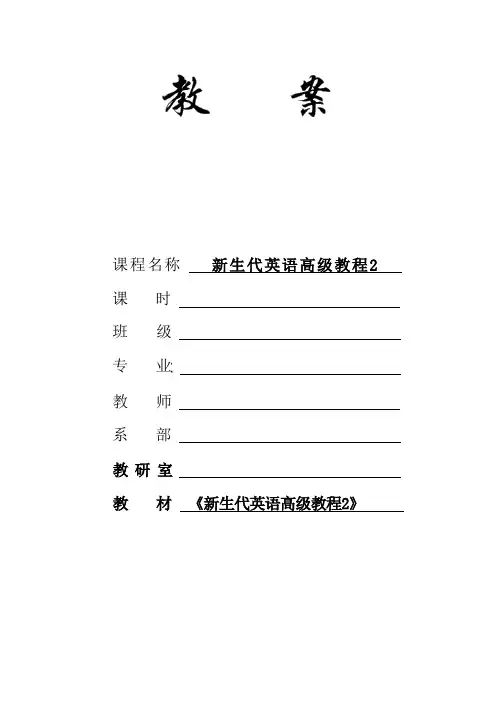
课程名称新生代英语高级教程2课时班级专业教师系部教研室教材《新生代英语高级教程2》补充教学资源Vocabulary Builder参考译文男:我有跟你说我的新爱好吗?女:没有,是什么?男:我开始对摄影感兴趣了。
女:摄影?什么类型的?男:其实,我喜欢给食物拍照片。
女:食物?听着有些无聊。
男:不!其实这非常酷。
我去餐馆给我点的食物拍照。
然后我把照片发布在我的博客上,并点评这些食物。
女:哦,所以这些照片是用来写餐馆评论。
有点意思……博客叫什么名字? 男:叫作“吃喝在纽约”。
你可以用谷歌搜索一下。
女:我会的!期待看你发布的文章。
Show Time 参考译文语言解析1.We take turns asking questions.我们轮流回答问题。
take turns: if two or more people take turns doing work,using something etc, they do it one after the other, for example in order to share the work or play fairly 轮流,依次;后可接动词ing或to do形式e.g. The students were taking turns Reading aloud.学生正在轮流朗读。
Dan and I usually take turns to cook.我和丹通常轮流做饭。
2.Well,let's start with Geography,because that's my specialty.好的,让我们先从地理开始,因为这是我的长项。
specialty: n.a subject or job that you know a lot about or have a lot of experience专长,专业e.g.Johnson's specialty is medieval European history.约翰逊的专业是中世纪欧洲史。
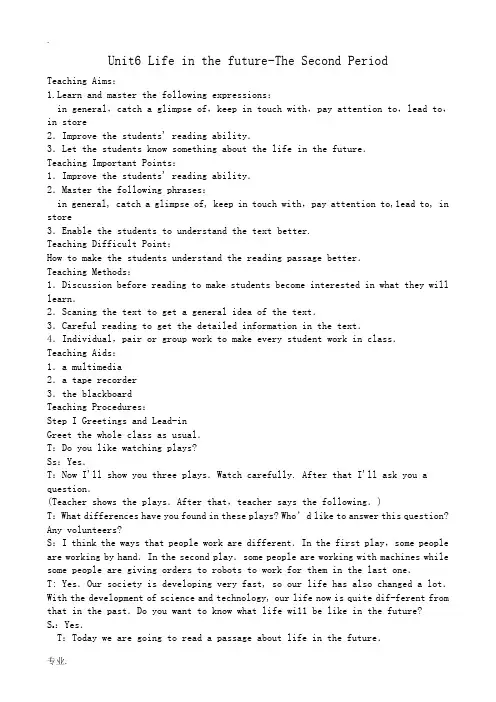
Unit6 Life in the future-The Second PeriodTeaching Aims:1.Learn and master the following expressions:in general,catch a glimpse of,keep in touch with,pay attention to,lead to,in store2.Improve the students' reading ability.3.Let the students know something about the life in the future.Teaching Important Points:1.Improve the students' reading ability.2.Master the following phrases:in general, catch a glimpse of, keep in touch with,pay attention to,1ead to, in store3.Enable the students to understand the text better.Teaching Difficult Point:How to make the students understand the reading passage better.Teaching Methods:1.Discussion before reading to make students become interested in what they will learn.2.Scaning the text to get a general idea of the text.3.Careful reading to get the detailed information in the text.4.Individual,pair or group work to make every student work in class.Teaching Aids:1.a multimedia2.a tape recorder3.the blackboardTeaching Procedures:Step I Greetings and Lead-inGreet the whole class as usual.T:Do you like watching plays?Ss:Yes.T:Now I'll show you three plays.Watch carefully. After that I'll ask you a question.(Teacher shows the plays.After that,teacher says the following.)T:What differences have you found in these plays? Who’d like to answ er this question? Any volunteers?S:I think the ways that people work are different.In the first play,some people are working by hand.In the second play.some people are working with machines while some people are giving orders to robots to work for them in the last one.T: Yes.Our society is developing very fast, so our life has also changed a lot.With the development of science and technology, our life now is quite dif-ferent from that in the past.Do you want to know what life wi11 be like in the future?S:Yes.sT:Today we are going to read a passage about life in the future.Step Ⅱ Pre—readingT:Now first let's learn some new words on Page 110.(Teach the words and explain them to the students.Then ask the students to read after the tape.At last teacher says the following.)T:OK.Now I want you to discuss four questions. Look at the screen.(Teacher uses the multimedia to show the questions on the screen.)1.How will people shop in the future?2.How will people travel in the future?3.What will schools be like in the future?4.What will the future be like in genera1?(Teacher gives the students four minutes to discuss and then collects their answers.Finally ask them to read the text to find out the answers to the questions.) Step Ⅲ ReadingT:OK.Please open your books at Page 43.Read the passage quickly to find out in which paragraph you can find the answers to the questions discussed just now.(Teacher gives the students enough time to read the text and then collects their answers.)Suggested answers:1.How will people shop in the future?Paragraph 3People can do online shopping(on the Internet)and they can go to a pleasant mall using smart cards.2.How will people travel/in the future?Paragraph 2We'll travel by car/taxi/bus/train that burns new fuels and uses new engines that will let us travel without worrying about whether we are polluting the environment3.What will schools be like in the future?Paragraph 5In the future,there may be more“ schools on the air 〞and “e-schools〞.We can study at home by watching educators on TV or on a computer screen.4.What will the future be like in general?Paragraph 1In general,the future will be brighter and our life will be more convenient.T:Now read the passage again and then answer the questions on the screen.This time,you should read slowly and carefully.(Show the following questions on the screen.)1.What will happen in the field of health and medicine in the future?2.Can you explain the meaning of e-learning?3.Why is it important to be lifelong learners?4.What should we do to make sure we will have a bright future?(Teacher gives the students five minutes to read the text carefully.Finally ask some students to answer the questions on the screen.They can have a discussion in pairs if necessary.)T:Now,who can answer the first question? Guo Li,would you like to have a try? S:People in the future will be able to enjoy a longer and healthier life and re- main active even in old age。

新生代英语高级教程2unit6【原创版】目录1.课文概述2.课文主题:科技与人类生活3.课文结构3.1 第一段:科技的发展及其影响3.2 第二段:科技对人类生活的影响3.3 第三段:科技的利与弊3.4 第四段:结论正文一、课文概述本课文选自《新生代英语高级教程 2》的 Unit 6,主要讨论了科技与人类生活的关系。
文章通过阐述科技的发展及其对人类生活的影响,进而分析了科技的利与弊,最后得出结论:科技在给人类带来便利的同时,也带来了一定的负面影响,我们需要合理利用科技,使其最大程度地造福人类。
二、课文主题:科技与人类生活2.1 科技的发展及其影响课文第一段主要介绍了科技的发展及其对人类生活的影响。
随着科技的进步,人们的生活方式发生了翻天覆地的变化。
例如,交通工具的发展使得人们出行更加便捷,通讯工具的普及使得人们沟通更加畅通,网络技术的出现使得人们获取信息的渠道更加多样化。
2.2 科技对人类生活的影响课文第二段具体分析了科技对人类生活的影响。
一方面,科技为我们提供了丰富的物质生活,满足了人们的各种需求;另一方面,科技为我们提供了便利的精神生活,丰富了我们的业余生活。
2.3 科技的利与弊课文第三段讨论了科技的利与弊。
科技的发展在给人们带来便利的同时,也带来了一定的负面影响。
例如,环境污染、资源浪费、网络安全问题等。
因此,我们在享受科技带来的便利时,也要关注科技带来的问题。
2.4 结论课文第四段得出结论:科技在给人类带来便利的同时,也带来了一定的负面影响。
我们需要合理利用科技,使其最大程度地造福人类。
新生代英语高级教程2unit6摘要:I.引言- 介绍新生代英语高级教程2unit6 的主题II.unit6 的主要内容- 概述unit6 的主要学习内容- 分析unit6 的重点和难点- 解释unit6 的学习目标III.学习建议- 提供针对unit6 的学习建议- 分享提高英语水平的方法和技巧IV.结论- 总结unit6 的重要性和学习意义- 强调坚持学习英语的重要性正文:【引言】新生代英语高级教程2unit6 的主题是“商务英语”。
这一单元旨在帮助学生提高在商务场合的英语交流能力,内容涵盖了商务会议、商务谈判、商务信函和商业礼仪等方面。
通过学习这一单元,学生将能够熟练地使用英语处理各种商务问题,提升自身的职业素养和国际竞争力。
【II.unit6 的主要内容】新生代英语高级教程2unit6 的主要内容包括:商务会议的流程和用语、商务谈判的策略和技巧、商务信函的写作规范和常见类型,以及商业礼仪的具体要求和实践应用。
在学习过程中,学生需要掌握这些方面的专业知识和英语表达,以提高在实际商务场景中的沟通效果。
【III.学习建议】针对unit6 的学习,建议学生多参与课堂讨论,积极与同学互动,通过实践练习来提高商务英语的实际运用能力。
此外,学生还应该多阅读商务英语相关的书籍和资料,观看商务英语的教学视频,参加商务英语角等活动,以拓宽知识面,增加实践经验。
同时,要坚持练习英语写作和口语,提高英语综合水平。
【IV.结论】总之,新生代英语高级教程2unit6 对于提高学生的商务英语能力具有重要意义。
通过认真学习这一单元,学生将能够在商务场合更加自信地使用英语进行沟通,为自己的职业发展增添筹码。
Unit2 第6课时教学设计第六课时Start to read Let’s check Story time一、教学目标:1. 复习颜色单词和字母,学习本课歌谣,进一步让学生了解英语的语音语调。
2. 做本课的听力练习,训练听力的同时检查学生对本课内容的掌握情况。
二、教学重点:复习本单元知识,做听力练习;学习有节奏、有韵律的歌谣。
三、教学难点:歌谣的学习以韵律为主,目的是进一步让学生了解英语的语音语调。
四、教学过程:1. 热身/复习(Warm-up/Revision)(1) 师生进行口语对话活动。
教师和学生作对话,为下面的生生对话做引路。
(2) 生生进行口语对话活动。
口语内容可与师生对话内容相同或不同。
(3) 游戏Simon says将颜色指令牌发给部分学生。
指令内容为第二、三单元的指令语。
如:Touch the ground. Touch your head. Turn around. White, white, Stand up.等等。
(4) 师生同唱歌曲Teddy Bear.2. 呈现新课(Presentation)(1) 教师播放第三单元A部分Let’s learn.的教学课件。
请学生用I can se e…的句型,说说图上的内容,如:I can see trees. I can see blue.教师重复颜色单词,并引出彩虹一词的学习。
T: Pink, red, yellow, green, blue… It’s a rainbow. I can see a rainbow."教师带读rainbow, I can see a rainbow.(2) 教师请学生拿出自己上节课做的陀螺或小雨伞。
将陀螺或小雨伞旋转起来,让同学之间相互猜猜旋转后的颜色。
(3) 教师拿出橙、棕、绿色的小球各一个,举起其中之一,如:紫色小球This isa ball. It’s a red ball. 全体学生共同跟读red ball。
Unit 6 The AdmirableWriting Workshop【教学目标】Students will be able to1. read and talk about writing a summary about “A Medical Pioneer”2. read for writing3. summarise information4. write a summary about “The Superhero Behind Superman”【教学重难点】1. understanding key components of a summary2. writing a summary about an article【教学过程】1. Tick the statements that are true about summary writing.1) Ask students to volunteer to read the sentences on page 62. Explain any difficult words.2) Students tick the statements that they believe are true about summary writing. This can be used as a baseline assessment.3) Discuss students’ answers.2. Read the summary of “A Medical Pioneer”, and answer questions.1) In small groups, explain to students that they will compare the news article with the summary on “A Medical Pioneer”. Students need to first read both texts. Then in the news article, students can underline the information that was used in the summary. This will help students to answer the questions.2) Students then answer the questions.3) Discuss the answers as a class.3. Divide and match.1) Read and discuss the instruction and the diagram.2) As you read the text “A Medical Pioneer” aloud, students follow along and complete the diagram. Suggest that students firstly match the phrase with the Part and then fill in the corresponding paragraph number.4. Read again and find out the main information.1) Suggest that the students use the same diagram for Activity 3.2) Ask students:a. What do you notice about the diagrams for the news article and for the summary?b. Why is the format important?c. What are the similarities and differences?5. Look at “The Superhero Behind Superman” and answerquestions.1) Suggest that the students use the same diagram for Activity 3 but with different phrases. Provide the following phrases for low level students (mix them up first): summary, personal information, achievements, accident, medical research, death.2) As you read the story “The Superhe ro Behind Superman”, students mind map the parts and what they focus on.3) Questions:a. How many parts can it be divided into?b. What does each part focus on?6. Read, find the main idea, underline key words and summarise.1) Ask students to volunteer to read the Writing Help box. Discuss the aspects of a summary and how to write a summary.2) As you read the paragraph, ask students to underline the key points.3) Students use these key points to write a sentence summarising the paragraph. Now students do this for each paragraph and compile a summary. This can be done in small groups if they need support.4) Students read their summaries to the class.7. Compose your writing: Drafting.1) Remind students that a draft is the first version of a piece of writing and that it is also called a rough draft because it is not “smooth” or finished.2) Have students draft their summary.8. Compose your writing: Editing.1) Remind students that the final stage of writing, before publishing, is editing. When we edit, we check that our ideas are clear and that our sentences are complete.2) Have students exchange their writing with a partner and offer each other suggestions to improve their drafts.3) After editing, writers will make changes to their drafts and either rewrite or print a clean copy of the work.4) Ask students to prepare a final draft of their work to submit for your review and then place in a writer’s portfolio.5) Students read their finalised summaries to the class.。
Unit 6 The AdmirableViewing Workshop【教学目标】Students will be able to1. read and talk about Martin Luther King’s speech2. view for understanding3. summarise information4. prepare a short speech about “My Dream”【教学重难点】1. summarising information of a speech2. presenting a short speech about dreams【教学过程】1. Watch the end part of a speech, find the main purpose, and discuss two quotes.1) Ask students to volunteer to read the two quotes. Explain any difficult words.2) Discuss each quotes:a. What is similar about each quote?b. What makes each quote striking?3) Discuss the questions as a class. Review what students remember about Martin Luther King.2. Watch and describe.1) Tell students they will watch Martin Luther King giving the speech. Ask students to take notes of what they notice in the video, the scenery and the audience.2) Discuss the students’ answers.3. Group Work: Talk about your feelings and explain why.1) In small groups students discuss the impression the speech made on them.a. How did the speech make you feel?b. How did the audience feel?c. What made the speech so powerful?d. What was the most interesting part for you?2) Play the video again if necessary.4. Group Work: Find repeated expressions and discuss their effects.1) Students should have already commented on the repetition of two phrases.2) Students write down the repeated phrases.3) Play the video, ask students to count how many times each phrase is repeated.4) In groups students discuss the effects of the repetition.5. Group Work: Watch again and discuss.1) Divide the class into groups of four. Each student chooses one aspect to talk about how it helped to achieve the overall impact of the speech. Refer to the notes below which will guide the students.6. Prepare a short speech “My Dream”.1) Divide the class into small groups and encourage students to talk freely about Martin Luther King’s speech and how the events in his life were channelled into his passion.2) Each student prep ares a short speech on “My Dream”. The speech needs to be personal and supported with logical reasoning. Encourage students to use some of the speech presentation techniques that they noticed in the video.3) Students present their speech to the class.。